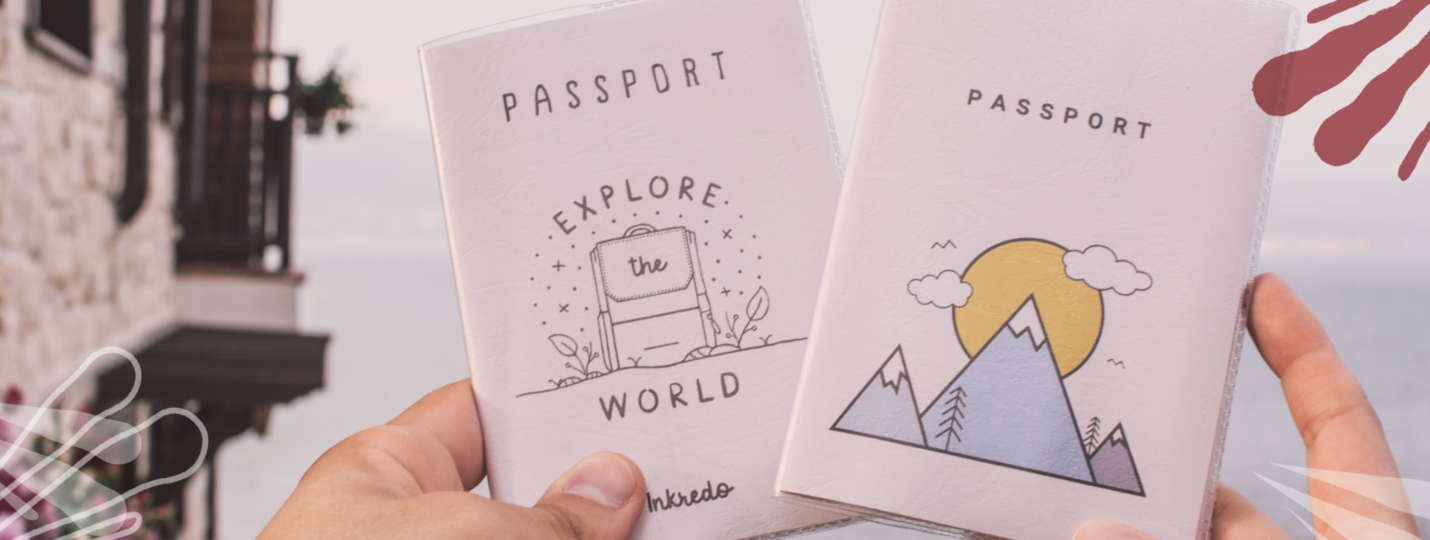
Visa vs. Passport
A visa and a passport can often be mistaken for each other. However, the two are entirely separate documents sharing a major characteristic in common: they’re both required for international travel.
Countries may have visa agreements between them that allow their citizens to travel visa-free to certain destinations. However, hardly ever can anyone travel internationally without carrying a valid passport.
Read on to learn about the definitions of a visa and a passport; and the properties that differentiate the two from one another.
What Is a Passport?

A passport is an official document of identification that includes a person’s name, address, photo, and information about the date and place of birth. In addition to personal information, a passport contains several blank pages for immigration officers to affix stamps each time you exit or enter a country while traveling internationally.
Passports are issued to the citizens by the governments of their countries of nationality.
International traveling almost always requires a passport. If you don’t carry a valid passport, customs and immigration officials can block your entrance or exit in and out of countries.
📝 An exception to the obligation to carry around a passport during international travels is the regulations in the Schengen Area. The Schengen Agreement, which includes 26 countries, allows passport-free travel within the member states of Schengen. However, even though the officials will let you in the country passport-free, you may not be able to fly without one because most airlines demand to see your passport to get on board.
What Is a Visa?
A visa is an official permit that governments issue foreigners to enter their countries. It can be valid for ten days, 30 days, 60 days, 90 days, or longer, but after the expiration date of a visa, you’re no longer allowed to stay in the country that issued it to you.
There are several requirements you need to meet to obtain a visa. These requirements may vary depending on the country.
While most countries require tourist visas, business visas, transit visas, employment or student visas, some countries allow visa-free entrance to citizens of certain countries. There are also countries that issue visas upon arrival.

Difference Between a Passport and a Visa
While a passport is a document of identification issued to a person by the government of their country of citizenship, a visa is an official permit issued by a foreign government to allow a person to enter their country legally.
The first is issued to enable a person to leave their country, whereas the latter permits that person’s entrance into a foreign country.
🛂 At times, travelers may get confused about whether they need a visa or a passport. To avoid such confusion, it’s best that you keep your passport around regardless of whether or not your destination requires it. This way, you won’t have to deal with any potential inconveniences if an official in a foreign country or an airline employee demands to see it. Also, don’t forget to do research on the country of your destination before you travel and apply for a visa if required.
Types of Passports
The issued type of a passport may vary depending on the profession or status of an individual, or the reason for application.
Regular Passports
These are the standard passports that can be issued to all the regular citizens of a country.
Service Passports
A service passport is a type of passport that’s issued to the officials of the government. The dependents of government officials can also obtain service passports.
Diplomatic Passports
Diplomatic passports are issued to diplomats for international travel. It also allows them to reside in foreign countries to serve state missions. The dependents of diplomats can also acquire diplomatic passports. However, holding a diplomatic passport doesn’t grant diplomatic immunity in a foreign country by nature, the diplomatic privileges are to be discussed with the country of destination.
Family Passports
Family passports are joint documents that allow a family to travel internationally. A family passport is held by one person and the rest of their family members are included in the travel document. This type of passport used to be quite common back in the day but nowadays, most countries issue separate passports to parents and their children.
Collective Passports
Collective passports are issued to people traveling in groups such as a bunch of students going abroad for a school trip.
Emergency Passports
Emergency passports are issued in cases of passport losses or theft. An emergency passport is typically a temporary document that provides the opportunity for immediate international travel. They expire when the actual document is delivered.
Types of Visa
There are various types of visas that are issued in accordance with the purpose of travel.
#1
Transit Visa
A transit visa only allows a traveler to transit through a country while traveling to other locations. The typical validation period for a transit visa is 24 hours but it can go up to two weeks.
#2
Tourist Visa
A tourist visa is generally issued for 30 to 90 days to people who travel for touristic purposes. There are some countries that issue 10-year tourist visas on the condition of periodical entries.
#3
Student Visa
Student visas are issued to students who want to study abroad. A student visa is valid throughout the relevant study program.
#4
Work Visa
Work visas are issued to those employed in a foreign country. A work visa is valid until the finalization of a work contract: so long as the contract gets renewed, the visa can be extended.
#5
Working Holiday Visa
Working holiday visas allow tourists to travel to foreign countries and work in specific industries, typically for a year or two.
#6
Business Visa
Business visas are issued to those who travel to a foreign country to conduct business there. The validity period of a business visa varies depending on the type of business and the destination. Business visa validity can go up to several months.
#7
Immigrant Visa
An immigrant visa allows a person to obtain a permanent residency permit in a foreign country.
#8
Retirement Visa
Retirement visas allow people who belong to the relevant age bracket and have the financial means to support their retirements abroad to retire in a foreign country.
#9
Pilgrimage Visa
Pilgrimage visas are issued for religious travels such as going on a pilgrimage to Mecca.
Other Travel Documents
Certificate of Identity: Travel document issued to non-citizens/the stateless, e.g., the Nansen passport
Refugee Travel Document: Travel document that’s issued to those who hold a refugee status and are unable to use their national passports
Interpol Travel Document: Travel document that provides effortless international travel issued to officers of the Interpol for transnational investigations
Travel Permits: Travel documents issued by countries to residents who are unable to use their passports due to personal conditions, e.g., Australia Immicard or Japan re-entry permit
Chinese Travel Document: Travel documents that are issued instead of regular passports by the PRC
How To Get a Visa
To get a visa, you’re required to apply for it at a consulate or an embassy of the relevant country. In addition to holding a valid passport, you must meet the visa requirements, such as delivering the required documents and paying the requested fees.
Before applying for a visa, make sure your passport does not expire any sooner than three months after your departure date.
What Happens After I Get a Visa?
If your visa application gets approved by the consulate or the embassy, they’ll either stamp your passport or hand you a separate document of a visa. If you got an electronic visa, on the other hand, you’ll have to print it out.
The Wrap-Up
To avoid mix-ups and inconveniences at airports or borders, it’s always best to carry a valid passport with you while traveling internationally.
If you do thorough research in advance on the visa regulations of the country you’re traveling to, on top of sticking to your passport at all times, you’re all good to go!
Bon voyage!
Related Articles
Digital Nomad Visas
Frequently Asked Questions
How to Obtain a Passport for US Citizens?
To get a US passport, start by completing an application and providing proof of citizenship, such as a birth certificate, naturalization certificate, or certificate of citizenship. Verify your identity with a government-issued ID, like a driver's license. Passports are typically valid for ten years and can be renewed afterward. The cost for a first-time adult passport is $145, with renewals every ten years at $110. Regular processing takes 6-8 weeks, but expedited service is available for an extra $60.
Do You Always Need a Visa to Travel Abroad?
While a valid passport is required for international travel, visa requirements depend on your citizenship, destination country, and the nature and duration of your study abroad program. For instance, US citizens may not need a visa to study in some European countries like France, Spain, and the UK.
What is a US Visa?
A US visa is an authorization for foreign citizens to enter the United States, placed in their passports. Some travelers may be eligible for visa-free travel under specific conditions. US citizens don't need a US visa but might need a visa from the country they plan to visit.
What Types of Visas are Available in the US?
US visas are divided into two categories: nonimmigrant visas for temporary travel and immigrant visas for permanent residence. The type of visa depends on the purpose of your visit.
What are the Different Visa Types?
There are various types of visas, including work visas, travel/tourist visas, business visas, student visas, refugee/asylum visas, working holiday visas, spousal visas, transit visas, and eVisas. The type required depends on the nature of your travel and activities.
What is a Visa Policy?
A visa policy determines who can enter a country without a visa. Policies often differ between countries, and some may be bilateral, allowing visa-free travel for each other's citizens. Factors influencing visa policies include diplomatic relations, illegal immigration history, cost, and tourism.
Why Do Some Countries Have Visa Restrictions?
Visa restrictions are in place to control visitor flow and prevent illegal immigration and other criminal activities. By requiring visas, authorities can vet potential visitors and ensure that their visit's purpose aligns with the visa type.
What Are the Requirements and Fees for a Visa?
Visa requirements and fees vary by country, so check the destination country's government website for details. Applications usually require forms, passport stamping, photographs, and supporting documents like flight itineraries, hotel bookings, or invitation letters.
What Are Visa Processing Times?
Visa processing times differ by country. Consult the destination country's government website for processing times. For example, visa applications from Russia to Canada take about 8 days, while Canadians traveling to India should apply at least 15 days in advance.
Where Can US Citizens Travel Without a Visa?
US citizens have visa-free access to most countries, thanks to their powerful passport. However, some countries like Russia, India, China, Vietnam, and Turkey require visas or e-visas. Check the Henley & Partners Passport Index and the US Department of State travel site for specific information on visa-free travel and country requirements.






